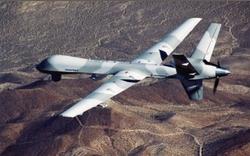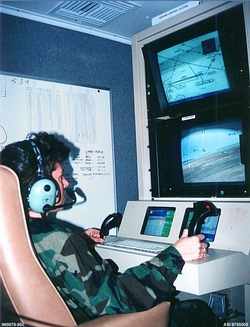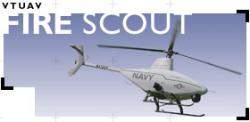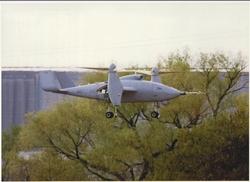New Technology Growing in War, and in Peacetime
Surveillance
The "Jumbotron" video screen had "Welcome to UAV Town, USA"
emblazoned across at site of the unmanned aerial vehicle flight
demonstration in Maryland Monday.

The demo occurred at the Webster Field annex to Naval Air
Station, Patuxent River. While not as sexy as "Fightertown, USA"
– the nickname given to Miramar Naval Air Station in
California – it was appropriate as all shapes and sizes of
unmanned aerial vehicles stood ready to show their stuff.
No Predators, though:
Unmanned aerial vehicles have been stars in
Operations Enduring Freedom and Iraqi Freedom.
 One official said the reason no
Predator UAVs were flying in the demonstration was "they're too
valuable. They're all on operations."
One official said the reason no
Predator UAVs were flying in the demonstration was "they're too
valuable. They're all on operations."
But they are not just valuable to military operations.
Protecting America is another mission these unmanned aircraft can
perform. Deputy Homeland Security Secretary Gordon England said the
vehicles will aid members of his department as they work to ensure
America's port and border security.
Soon to move from watching emeny without to enemy (and
everybody else) within...
"This issue of terrorism is not transitory," said England, who
served as Navy secretary before taking this post. "Until the
(Berlin) Wall came down in 1989, we fought communism for 40 years
with the very best technology America had to offer. And we will in
a similar situation in regard to terrorism."
 In fact, England said he
has asked DoD to deploy UAVs with agencies of the Department of
Homeland Security. The aircraft will fly along the U.S. southern
border. This will allow members of the new department to "gain some
experience, some background, some hands on with the technology,"
England said. "This is a very first step for us as we move into
this new area of UAV technology."
In fact, England said he
has asked DoD to deploy UAVs with agencies of the Department of
Homeland Security. The aircraft will fly along the U.S. southern
border. This will allow members of the new department to "gain some
experience, some background, some hands on with the technology,"
England said. "This is a very first step for us as we move into
this new area of UAV technology."
The Navy's Program Executive Office for Strike Weapons and
Unmanned Aviation and the Association for Unmanned Vehicle Systems
International co-sponsored the event. It is part of the AUVSI
convention that will continue in Baltimore through July 17.
The demonstrations highlight the strides made in the field and
gives contractors and government personnel a chance to "network"
with each other, said Rear Adm. Jack Chenevey, program executive
officer.
Among participants were Northrop Grumman, flying both the Fire
Scout and the Hunter; Boeing, with its ScanEagle; DRS, the Sentry
HP; Schiebel, the Camcopter; and Yamaha, the RMAX.
Other companies showed off their latest, including Aurora Flight
Sciences with the GoldenEye-50; Innocon, the Mini Falcon; and
MMIST, the SnowGoose.
They used to be just little observers; now, they're
remote-operated killers...
"What you see here is how the field is changing
and expanding," said a Naval Air Systems Command official.
 "When we held this the last
time in July 2001, the emphasis was on data and pictures. Now the
Predator is armed and flying missions. The Defense Department is
sinking serious money in the unmanned combat air vehicles, and all
sorts of other uses are being considered for these platforms."
"When we held this the last
time in July 2001, the emphasis was on data and pictures. Now the
Predator is armed and flying missions. The Defense Department is
sinking serious money in the unmanned combat air vehicles, and all
sorts of other uses are being considered for these platforms."
"These are very economical," said Clark Butner, who works with
the command's special communications division at nearby Naval Air
Station Patuxent River. "They are getting easier to fly, and
require fewer people and pieces of equipment to operate." For
example, Butner called the walking away price of the SnowGoose
– about $250,000 – "digit dust" when compared to the
overall DoD budget.
Many vendors are branching out of the purely
military applications for their products.
 "There is a market for these
platforms with the Department of Homeland Security," said Ken
Zugel, director of flight operations for Aurora Flight Sciences in
Manassas (VA). The vehicles can stay in the air for extended
periods of time and the technology is such that now it doesn't take
a huge piece of equipment as a ground base, he said. They also can
operate from "austere" environments.
"There is a market for these
platforms with the Department of Homeland Security," said Ken
Zugel, director of flight operations for Aurora Flight Sciences in
Manassas (VA). The vehicles can stay in the air for extended
periods of time and the technology is such that now it doesn't take
a huge piece of equipment as a ground base, he said. They also can
operate from "austere" environments.
In fact, Zugel's company is working with NASA on one of the more
far-out UAVs called the Mars Flyer. If all goes well, that UAV will
give scientists a close-up view of Mars and send back test results
of air samples taken in the Martian atmosphere. Zugel said the
company has tested the Mars Flyer by dropping it from a balloon
that brought the craft to 100,000 feet.
[Thanks to Jim Garamone, American Forces Press Service
--ed.]
 ANN's Daily Aero-Linx (11.25.25)
ANN's Daily Aero-Linx (11.25.25) NTSB Final Report: Glasair GlaStar
NTSB Final Report: Glasair GlaStar ANN FAQ: Turn On Post Notifications
ANN FAQ: Turn On Post Notifications Classic Aero-TV: Red Tail Project Update Taking the Mission to the People
Classic Aero-TV: Red Tail Project Update Taking the Mission to the People Airborne 11.24.25: ANN's 30th!, Starships V3 Booster Boom, Earhart Records
Airborne 11.24.25: ANN's 30th!, Starships V3 Booster Boom, Earhart Records






